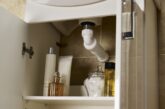
Designed by a builder, the Waterblade can make substantial savings on usage
Water is becoming an ever more precious commodity and how we manage our resources is now one of society’s great challenges. Add to that substantial increases in utility bills, and the issue is all the more pressing. A builder from Brighton is championing water efficiency with a device of his own invention, and the savings are significant.

“I’ve been in the building industry my entire career,” explains Nigel Bamford, “and, like anyone who has earnt their living in the sector over the last few years, I am acutely aware of the pace of change, with new regulations on energy efficiency coming in all the time. That’s what motivated me to undertake a Masters Degree in the Energy Use of Buildings, which I completed whilst running a successful loft conversion company on the south coast. I’m a carpenter by trade but my studies have also given me an understanding of the bigger picture. It is through that combination that I learnt how scarce a resource water is, and the amount of energy we use to heat it.”
The number of utility areas that are designated as water stressed is, in fact, growing. An ageing infrastructure and leaks are certainly part of the problem, but patterns of usage also need to change, even of the most everyday kind.
“The principle behind the Waterblade is to make smaller amounts of tap water more useable and functional,” continues Nigel. “That was the origin of the idea of a sheet of water that will wash your hands. I was initially tinkering with various designs at home, with everything from lengths of hose to plasticine, marbles and epoxy resin. Even from those crude prototypes I satisfied myself that I was onto something.”
The breakthrough moment came when the Green Growth platform pointed the Waterblade inventor towards applying for a grant from Innovate UK. Not only was there funding available but it put Nigel in touch with the University of Brighton, giving him access to 3D printers, and an academic team who could calculate the fluid dynamics behind the product. Even with that kind of support, however, getting the Waterblade to market was far from a smooth and linear progression.
“It actually took around four years before we were in possession of a market-ready, accredited and WRAS approved solution. In that time we forged a relationship with a very large company with whom we have developed a complementary flow control unit, for example, and there was a lot of trial and error.”
So just how does it work?
Nigel’s water saving solution is effectively two technologies. The first is the Waterblade itself, which uses the surface tension of the water to modify the flow. The result is a paper thin sheet, which is useful for washing and rinsing. The flow control system responds dynamically to water pressure, providing a constant flow. It effectively complements the Waterblade by ensuring the correct flow for that sheet of water to form and remain stable. The result is an impressive water saving of up to 50 per cent or more, with the associated gains of not heating up as much hot water in the first place.

Moreover, where new developments are limited by the capacity of the existing water supply, reducing demand in this way facilitates new housing and other developments to proceed. The device fits most mixer taps, and can be easily retrofitted in five minutes, thereby representing a useful upsell for plumbers to existing clients.
“The truth is that, when I started on this journey, I had no idea of what I was launching myself into,” Nigel confesses, “but I believed in what I was doing, have really enjoyed the process, and there was some helpful encouragement along the way. We were able to persuade some utility companies to fit them for their clients, for instance, there was a win at the Water Industry Achievement Awards, and at Ecobuild’s Big Innovation Pitch.
“As well as that, I am very confident that innovations like the Waterblade can make a real difference. Since the 1960s the amount of water people use in the UK has increased by 66%. We are now consuming 141 litres of water per day. If present levels of consumption continue – not just for us but worldwide – two-thirds of the global population will live in areas of water stress by 2025.”

The cost-of-living crisis has brought what householders pay in bills into sharp focus. Add to that an increase in water metering and the appeal of Nigel’s invention is clear. He has already attracted interest from a number of large organisations, including the Premier Inn Hotel Chain but, whether it’s commercial or residential use, the Waterblade is a deceptively simple but effective solution.
For further information on the Waterblade visit Home | Waterblade (thewaterblade.com)







